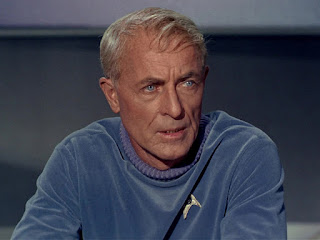"Escape from Tomorrow"
Airdate: September 13, 1974Written by Art Wallace
Directed by Don Weis
Synopsis: Two astronauts survive a crash-landing on a planet where intelligent apes rule over humans. They find that their very existence challenges the ape orthodoxy and puts their lives in danger.
Jason: So, I read the original pilot script was by Rod Serling. Was it deemed too dark and challenging for TV? Was his treatment anathema for those hopeful of product tie-ins, like toy lines and lunchboxes?
Trey: They did bring in Ruby and Spears, so your theory may have some merit. But to first episode we got: First off, I really like the opening credits sequence, particularly the theme music composed by Lalo Schifrin.
Jason: I enjoyed the theme music especially. The creepy, disruptive violins in the first seconds set a tone of horror and confusion entirely appropriate to the franchise. It's no Mission Impossible theme (one of Schifrin's greatest hits) but it evokes mood and braces the viewer for surreal weirdness to come. Can this episode live up to its opening montage?
Trey: It would be hard! And so, here's character actor Royal Dano looking like an aging hippie. He's perhaps best known as the voice of animatronic Lincoln in the "Hall of Presidents" at DisneyWorld. Dano, his voice, and style of dress and the terrain really give this a Western vibe--much more than the original films had.
Jason: Dano looks like an aging hippie living in an ancient fallout shelter who still finds time in his off-camera moments to maintain a meticulously close shave throughout his appearances. Hygiene practices on the POTA will be on my mind from this point forward!
Trey: That sounds like a threat!
Jason: We'll see. The Western vibe you mentioned, and the relentless earth tones keep things grounded, maybe too grounded! At least they had a nice full size prop of the crashed spaceship to remind us of the far-future setting.
Trey: Same one from Beneath the Planet of the Apes, I think. It looks a bit small for an interstellar craft here, but we'll chalk that up to advanced technology.
We get a nice establishing shot of the ape city and find that Central City (in what was apparently once California) has a Dr. Zaius just like Ape City on the East Coast of the first film. Maybe it's just a common name?
Jason: Possibly! Certainly not just to keep things simple for the presumed audience...
Trey: I guess that might also be the reason for casting Roddy McDowell. He was in all the ape films, and he's here as a new character, Galen.
Jason: He turns in a fine performance, as expected. I also thought the astronaut leads, who I will refrain from calling Starsky and Hutch, handled their roles creditably.
Trey: Ha! I thought about the Starksy and Hutch resemblance as well. Same types. But you know, this show predates Starsky & Hutch!
Jason: So Starsky and Hutch are really Virdon and Burke types.
Trey: Sounds like the name of a law firm. But anyway, let's talk about our antagonist. The astronauts' Javert, General Urko. He's played by Mark "Sarek" Lenard. Apparently, the character's name was originally going to be "Ursus" like the similarly garbed military leader in BtPotA, but it has changed to "Urso" by the time of Lenard's audition. Lenard had trouble saying the name through the makeup so it became "Urko."
Jason: It feels like his portrayal here is still a work in progress. Urko's staccato speech is only rarely less than a commanding shout, but I have faith in Lenard's professionalism to bring some subtlety to the role as the series wears on.
Trey: We are told "more than 10 years ago, another such ship landed." Interesting that astronauts keep landing in the future.
Jason: A disturbing trend, for sure!
Trey: I don't know how
ANSA keeps their funding, losing so many astronauts. Surely there were Congressional hearings.
Also, time for a series continuity nitpick: The image in the book of a city (New York, maybe) is "2503" violates the timeline of the series as established in the films where a nuclear war destroyed it in the early 21st century.
Jason: Viewers like me, many of whom have only seen the first movie in a pre-VCR age, can't have been overly concerned with ape continuity.
Trey: I'm glad we live in a more enlightened age! Anyway, there's a lot more business that goes on, but my verdict on this episode...
Jason: Yes, let's have it!
Trey: My verdict: It's hard to put oneself in the mindset of seeing this on TV in 1974, but from my 2023 vantage, it's a middling start, at best. The characters (both protagonists and antagonists) get well introduced, and Galen's journey to rebel is credible, but there's just too much classic TV capture, sneak, run. It feels like a few "mini-episodes" jammed together. Still, good cast and production design.
Jason: I think I liked it more than you. I enjoyed the episode, and thought it was successful in resetting the scenario of the first film for a fresh start...but yeah, it's 70's TV. My expectations were set so low, they would have had to work hard to undershoot them. I had fun! Were I not constrained by the format of this blog series, I would have binged on--at least for another episode.
Trey: That's the right attitude! Like Burke and Virdon, we've got to keep searching just over the next horizon!





















